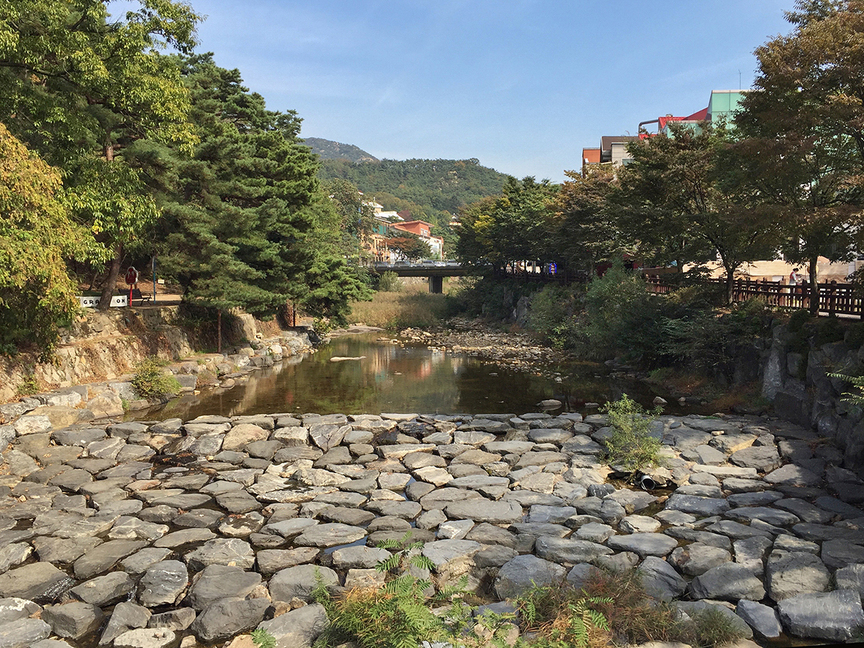While Anyang is generally considered a satellite city, its history dates back to the Goryeo Dynasty (918–1392) with the establishment of the Buddhist temple Anyang-sa. The city is surrounded by five mountains and eight rivers and streams. It is a popular weekend destination among locals for hiking, trekking and spiritual pilgrimages. What also makes Anyang unique is the large number of public artworks that dot the mountain trails. All photos by Elaine W. Ng for ArtAsiaPacific.
APAP begins unofficially in the Anyang Pavilion, designed in 2005 by ÁLVARO SIZA VIEIRA, together with CARLOS CASTANHEIRA and JUN SUNG KIM. Inside the open hall contains Rock Pillow Garden (2016) by CHRISTINA KIM, a group of numerous comfy cushions and pillows of varying shapes and sizes. Kim, the brains behind Dosa, a Los Angeles-based textile and fashion company with a cult-like following, retains childhood memories of family visits to Anyang. Using natural fibers and dyes, including tealeaves and pomegranate skins, she created cushions that resembled some of the rock formations found in the area. Visitors can take the opportunity to lounge and kick their feet up on these cushions before, during and after APAP 5. The cushions will also come in handy when Yogjakarta-based art collective House of Natural Fiber hosts their workshops in the pavilion during the festival.
Also inside the Anyang Pavilion, behind the information desk, is a storage system created by CHOI JEONG HWA, whose work also appeared in the very first edition of the APAP. In this new commission, entitled The Gateless Gate (2016), the artist has lined up traditional ornate Korean cabinets—ones that were donated and well as salvaged—to create one long storage unit for use by the administrative team of APAP.
Detail of CHOI JEONG HWA’s The Gateless Gate (2016).
Outside the Anyang Pavilion, if one looks closely enough at the structure’s roof or nearby trees, you will catch the extremely subtle bird-nest sculptures by Argentinian artist ADRIÁN VILLAR ROJAS. The “Brick Farm” series (2016) consists of 80 nests built by Argentina’s national bird, the rufous hornero, which Villar Rojas has carefully installed into the natural habitat of Anyang.
More projects can be found at the Kim Chung Up Museum (Kim was a pioneering modern architect), including a work by artist duo MIXRICE, recent winners of the Korea Art Prize. For APAP 5, they are showing 21st Century Light of the Factory (2016), a mixed-media work consisting of a video, wall drawings and photographs that were inspired by Light of the Factory (1978), a minjung (peoples’) play. Here mixrice collaborated with the now-defunct Maseok Migrant Theatre, together with young Koreans, contractors, dismissed workers and migrant laborers from Bangladesh, to examine the lives of ordinary people.
Detail of MIXRICE ’s 21st Century Light of the Factory (2016).
In a building adjacent to the Kim Chung Up Museum complex is BYRON KIM’s Contemplation Room (2016). During research for his participation in APAP 5, Kim discovered that the museum is located on the site of Anyang-sa, the thousand-year-old Buddhist temple from which the city takes its name. This room for silent mediation, along with a small painting based on the colors of the Buddhist flag in the main building of the museum, was Kim’s acknowledgement of the site’s origins and his attempt to restore spiritual content to the historic location. While the work may appear like a minimalist installation, museum docents actively encourage visitors to sit on the cushions and meditate their own consciousness.
APAP 5 also urges visitors to venture into the wilderness to find artworks. For example, London-based Colombian artist OSCAR MURILLO’s commissioned paintings, for the souls of the rotten mighty (2016), were hand-delivered by the artist from London to Anyang to be exposed not only to the natural elements, but also before local shaman Kim Ju Young. Together, Kim and Murillo performed shamanistic rituals on the paintings. Afterwards, Murillo rolled up the canvases and trekked up the Samseong Mountain, where he installed them among the pine trees that cover the hillside. Over time, the works will decompose and assimilate into the natural surroundings.
Further to the east along the mountainside, with luck one could encounter MICHAEL JOO’s Mediator (Anyang) (2016). The work was inspired by Anyang’s Buddhist origins as well as Joo’s hikes up Samseong Mountain in May. Joo dug a hole in a cliff and layered it with cobblestones. In the center he placed a copper post, or “antenna,” which made the work appear like an archaic satellite dish or ancient sundial. The post also acts as a lightning rod to prevent forest fires.
Works have also been installed around small shops and businesses throughout Anyang, including Korean artist HEO KANG IL’s mural in Sonamoo-zip, a local restaurant.
Here HEO KANG IL paid homage to the restaurant’s owner, noted for her cheerful disposition while serving classic Korean cuisine to local residents.
At the far end of Anyang Art Park is New York artist LISA SIGAL’s subtle intervention, Anyang Pools: Fifty Meters of Civic History (2016). For much of the 20th century, Anyang was a popular recreation destination; in particular, its swimming pools attracted visitors from near and far. Sigal sought to remind audiences of Anyang’s more recent history, by restoring a section of a wall and the seating area of Manan-gak Swimming Pool, which was built in 1968, but now serves as the decaying backdrop to a parking lot. She has given the pool wall a new coat of paint and rebuilt the original stone bleachers, leaving traces of eroded paint as a way of drawing attention to the passage of time.




